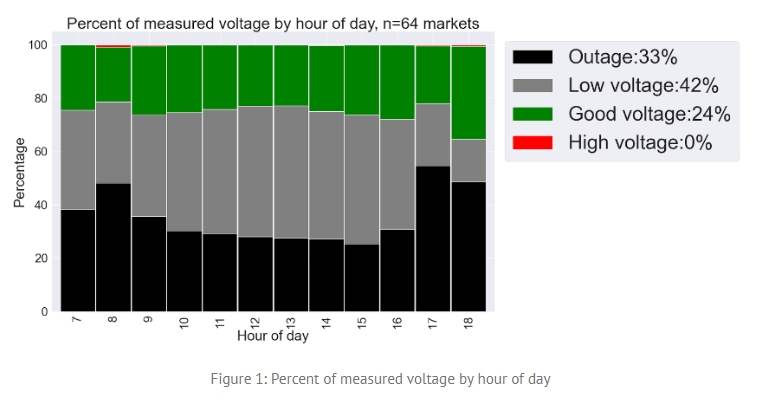
Access to electricity is expanding globally, but challenges persist. While more people are gaining connections to power grids, issues such as frequent outages and poor power quality remain widespread, particularly in developing regions.
Poor power quality, often characterized by voltage fluctuations and inadequate electrical performance, affects millions of users.
It hampers their ability to use electricity effectively, reduces productivity, and slows economic development. Despite its significant impacts, poor power quality receives far less attention than other energy access challenges.
Poor power quality can take many forms, such as unstable voltage levels, harmonics, and inadequate frequency regulation. These issues are especially common in regions with aging or capacity-constrained infrastructure. While access to electricity has been a major focus of global development efforts, the quality of that electricity is equally crucial.
When the voltage is too low, appliances cannot operate efficiently or may not work at all. On the other hand, excessive voltage can damage sensitive equipment, leading to costly repairs and replacements. Beyond these immediate impacts, poor power quality suppresses demand for electricity. People are discouraged from investing in appliances or scaling up their operations because they cannot rely on the electricity supply. As a result, poor power quality acts as a brake on economic growth, hindering the productivity of industries and businesses.

Nigeria, Africa’s largest economy, provides a stark example of how poor power quality can hold back progress. Despite its economic potential and growing population, Nigeria struggles with a lack of reliable and quality power supply.
To assess the scale and impact of these issues, e-GUIDE conducted an energy audit across 74 commercial markets in six regions of Nigeria. The findings revealed widespread problems with power quality and reliability. electrical systems, medical equipment, power factor
Across these markets, only one in four voltage readings fell within an acceptable range. Extremely low voltage was a recurring issue, accounting for approximately 40% of the readings. In contrast, power outages occurred in about one-third of the samples.
While outages are often the focus of discussions around energy poverty, the prevalence of low voltage highlights a more insidious issue: even when electricity is technically available, it may be insufficient or unsafe to use.
For businesses in Nigeria, poor power quality is more than an inconvenience—it is a major barrier to growth. Many appliances, such as air conditioners, refrigerators, and industrial machines, are designed to operate within specific voltage ranges. When the voltage drops below this range, the equipment cannot perform properly. In extreme cases, it may be damaged beyond repair. Business owners in Nigeria report having to replace appliances frequently or invest in expensive protective devices like surge guards and voltage stabilizers.
One saloon owner shared an example of how poor power quality limits their operations. When they tried to use a second air conditioner, the voltage dropped so much that neither unit could function. They eventually returned the second appliance, unable to justify the cost without a reliable power supply. Another business owner explained how customers sharing the same line often face restrictions on running appliances like refrigerators or fans. These limitations reduce operational efficiency and stifle growth.
The financial toll of these challenges is significant. Businesses must allocate funds to repair or replace damaged equipment, purchase backup generators, and invest in voltage stabilizers. These additional expenses eat into profits, making it harder for small enterprises to scale up or innovate. Furthermore, poor power quality often creates a vicious cycle: businesses that cannot grow are less likely to invest in equipment or expand their operations, which in turn limits overall demand for electricity and slows economic development.
The challenges faced by businesses in Nigeria are not unique. Similar issues are observed in other developing regions, including informal settlements in Uganda, rural communities in Kenya, and urban centers in India. Poor power quality undermines efforts to achieve universal access to affordable, reliable, and sustainable energy—a key goal of Sustainable Development Goal 7 (SDG7).
One of the main reasons poor power quality remains underaddressed is the lack of consistent measurement systems. While power outages are easy to identify and track, issues like voltage fluctuations and harmonic distortions are harder to monitor. Utilities and policymakers often lack the tools needed to assess the full extent of the problem. This lack of data makes it difficult to design effective interventions, leaving many communities to cope with substandard electricity.
Another challenge is the long-term impact of poor power quality on consumer behavior. When people experience frequent power quality issues, they become less likely to rely on electricity for productive purposes. This phenomenon, known as demand suppression, can have far-reaching consequences for economic growth. If businesses and households avoid using electricity because they cannot trust its quality, the benefits of expanding access to electricity are significantly diminished.
Addressing poor power quality requires a coordinated effort among utilities, policymakers, regulators, and investors. The first step is to establish robust measurement systems that can track power quality metrics in real time. By understanding the scale and nature of the problem, stakeholders can identify priority areas for intervention.
Utilities need to invest in modernizing grid infrastructure to reduce voltage fluctuations and improve reliability. This may include upgrading transformers, reinforcing distribution lines, and deploying advanced monitoring systems. Policymakers, meanwhile, must ensure that power quality standards are integrated into energy planning and regulatory frameworks. Without clear guidelines and enforcement mechanisms, utilities may lack the incentive to address quality issues proactively.
Investors and donors also have a critical role to play. Many energy access initiatives focus on expanding connections, but more attention should be given to the quality of those connections. Funding for grid modernization, smart sensors, and training programs can help utilities improve service delivery and ensure that electricity is both accessible and usable.
One promising solution to poor power quality is YT Electric’s Active Harmonic Filter (AHF). This innovative technology addresses harmonic distortions—a common cause of power quality issues—by dynamically compensating for voltage fluctuations and current imbalances. By stabilizing the power supply, the AHF protects sensitive equipment, reduces energy losses, and enhances overall grid performance.
For businesses, the benefits of the AHF are immediate and tangible. With improved power quality, appliances operate more efficiently, last longer, and require fewer repairs. This translates into lower operating costs and higher productivity. Moreover, by reducing the need for backup generators and voltage stabilizers, the AHF helps businesses save money and reduce their environmental footprint.
On a larger scale, the AHF can play a vital role in improving grid reliability and supporting economic development. By addressing one of the key barriers to productive electricity use, it enables industries and communities to fully realize the benefits of electrification. As countries like Nigeria work toward achieving SDG7, technologies like the AHF will be essential in ensuring that electricity access translates into real economic and social progress.
Poor power quality is a critical issue that deserves far more attention from policymakers, utilities, and investors. It undermines the benefits of electrification, suppresses economic growth, and imposes significant costs on businesses and households. Addressing this challenge will require a combination of better measurement, targeted investments, and innovative technologies like YT Electric’s Active Harmonic Filter. By prioritizing power quality alongside access, we can ensure that electricity serves as a true driver of sustainable development.
Subscribe to us to enjoy event prices and get some of the best prices.
 IPv6 network supported
IPv6 network supported

